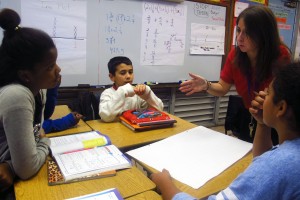Why Elementary Math Lessons Are Changing In Florida Schools

John O'Connor / StateImpact Florida
Frances S. Tucker Elementary School fifth grade math teacher Yaliesperanza Salazar leads her class through an exercise to group data on a line graph.
At dinner tables across Florida, parents and their elementary school children are trying to solve a math problem: What’s going on with my kid’s homework?
Florida is one of dozens of states that has switched to new math standards based on Common Core. The standards outline what students should know in every grade.
Experts say it means big changes to how math is taught. More focus on understanding concepts and solving problems multiple ways. Less memorization of formulas and grinding out worksheets full of similar problems.
Math is a constant conversation for Jessica Knopf and her fifth-grader, Natasha.
They talk about math at the dinner table. They send questions and answers by phone. They sought tutoring in online videos.
“When this Common Core stuff starting coming home,” Knopf says, “it wasn’t something I could just scribble and go ‘Oh, here it is.’ No. I had to stop. I had to think about it. I had to go online to Khan Academy. I had to bring my husband in. It wasn’t logical.”
NEW THINKING PROCESS

John O'Connor / StateImpact Florida
Jessica Knopf and her daughter, Natasha, after a homework session.
Florida’s new math standards are tough. They’ve meant more homework for kids.
Most nights, Natasha’s math homework takes about two hours most nights. This evening she’s correcting errors from a recent test. One question asks her to write an algebraic equation to figure out the price of a DVD. Another requires her to recall the commutative property of addition when figuring out the price of several packages of ground beef.
In every case, she has to provide a written explanation of what she did wrong and how she got to the correct answer. And show her work.
Natasha says she has had to cut back on hobbies.
“I would like to have time to do more dance,” she says. “And I auditioned for a company at a studio, but it was too many hours for me to do. And my mom said I couldn’t because the amount of homework I get is just a lot.”
Natasha’s mom says the parents in her South Miami-Dade County neighborhood have similar complaints.
And the new methods of solving math problems are unfamiliar to a lot of parents.
“It’s been very frustrating,” Knopf says. “I’m not going to take the time to learn this to teach her. I’m going to teach her my way.”
VISUAL PROBLEM SOLVING
The goal is that kids understand how and why a mathematical concept works says Maria De Armas, the assistant superintendent for academia with Miami-Dade schools.
“Teachers will spend a much longer period of time with one problem,” she says, “doing it in many different ways.”
It’s like knowing a word is an adverb because of how it’s used rather than just because the word ends in –ly.
Schools across the county held sessions to help explain to parents what’s new with math lessons.
“Yeah, it’s going to be difficult. It’s going to be different,” De Armas says. “If it isn’t, then I’m concerned…If there wasn’t concern from parents, I would be worried because things are not changing.”
Schools still teach the traditional method for addition, subtraction, multiplication and division.
But you’re more likely to see visual techniques too — like making a diagram, a matrix or drawing a picture. The more ways they solve a problem, the more students make the connection between numbers and concept.
TRADITIONAL METHODS

John O’Connor / StateImpact Florida
Frances S. Tucker Elementary School fifth grade teacher Yaliesperanza Salazar. Math lessons are carefully designed to match Florida’s new Common Core-based standards.
Students at Frances S. Tucker Elementary School in Coconut Grove are learning about a line plot – a way to visualize and organize data.
These students are counting whether someone has one-quarter, one-half or three-quarters of a glass of apple juice. They add a dot for each amount, stacking four dots above one-quarter on the number line.
The lesson is carefully structured for the new math standards — not by the classroom teacher, but by experts from the school district. They’re the ones who pick questions from the textbook to use in class.
Fifth grade math teacher Yaliesperanza Salazar starts by reviewing recently completed lessons.
Then she explains the day’s goal to the entire class.
Finally, the class breaks up into small groups to create their line plots illustrating the cakes, chocolate bars and other treats students ate. The final goal: come up with the size of the average student’s share.
Most parents are seeing these techniques for the first time. These techniques are not actually new. Many are part of a broader movement called reform math to change the way the subject is taught.
But drawing a diagram can take longer. There’s more emphasis on writing explanations for answers.
Barry Garelick started teaching math several years ago after retiring from the Environmental Protection Agency. He didn’t like what he saw his daughter being taught.
Garelick says there is a lot to like about Common Core – particularly the way lessons build on each other. But he also says schools should still emphasize traditional skills, like memorizing multiplication tables. He says the standards sometimes aren’t clear when concepts should be taught.
He disagrees that math education needs an overhaul.
“Part of this groupthink is that traditional math has failed and that we need a new way to teach it,” Garelick says.
“Some parents may not have been good in math,” he says, “and they’ll buy into the excuse ‘Oh, that’s why I’m not good in math.’ And so they’ll believe it. They’ll put their trust in the school.”
At Jessica Knopf’s dinner table, Natasha prefers her mom’s way to the school’s way.
“Now they’re teaching you with models that I really don’t understand the lesson,” she says. “That’s why when I come home, I ask for my mom’s method.”
Her mom says she sees the benefit of the changes – she’s thinks visually too. But if the homework keeps stacking up like this, she might take Natasha out of her advanced classes.
